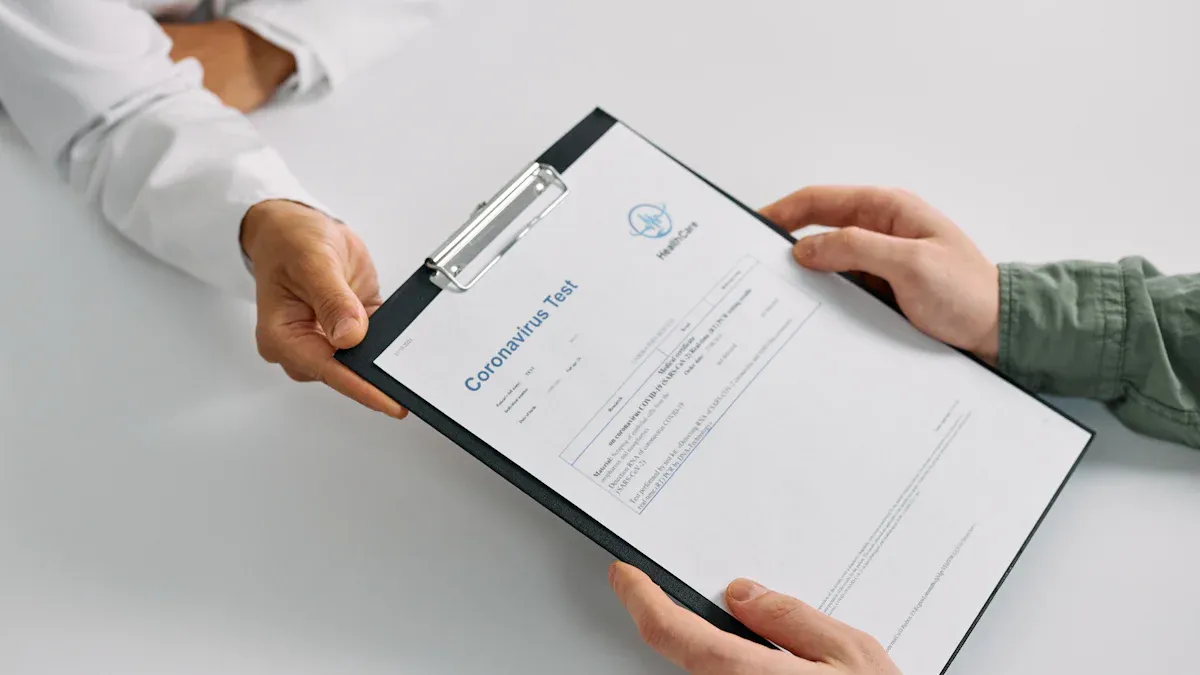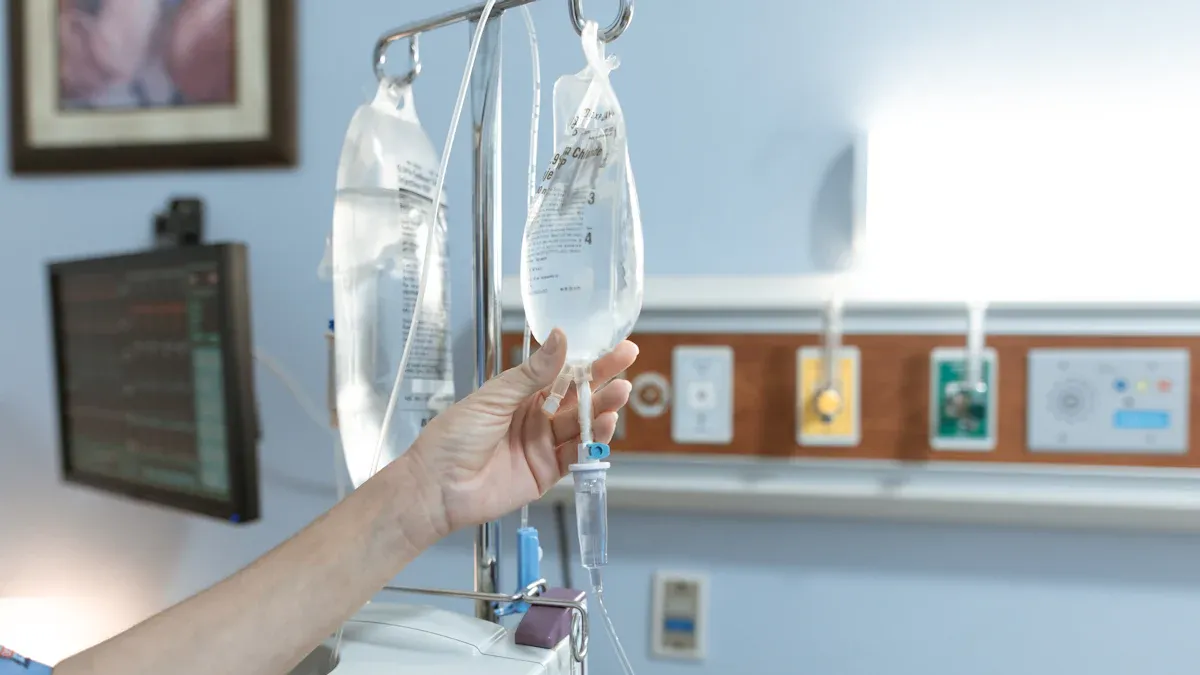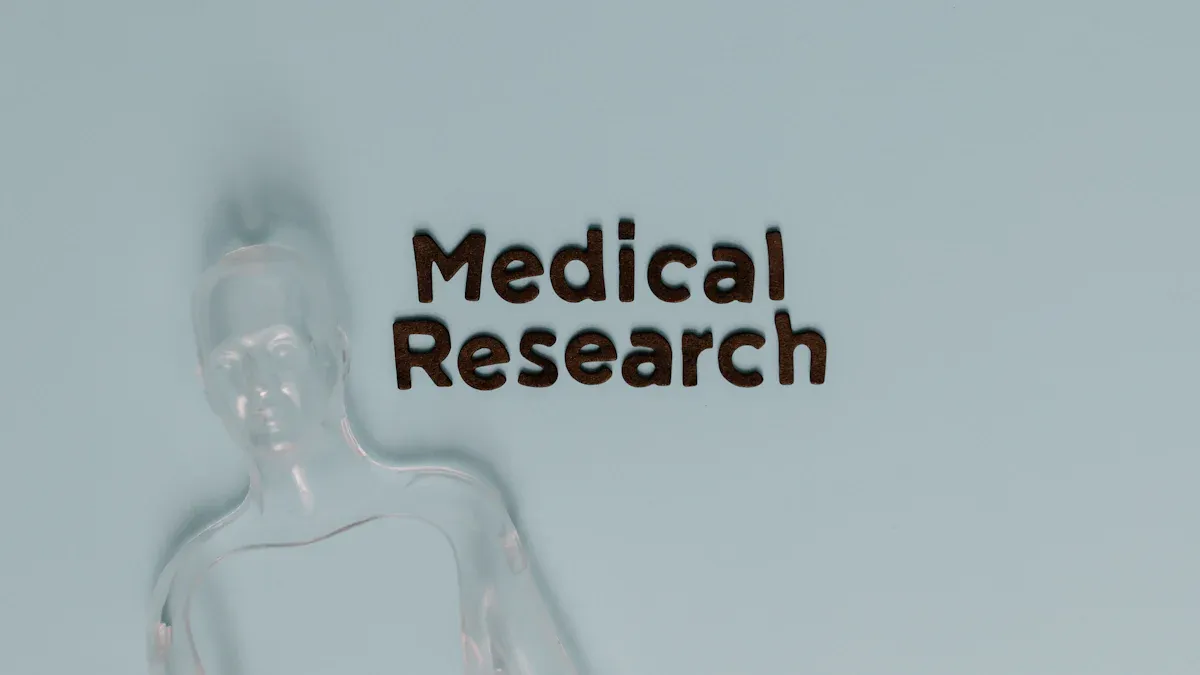2025 Sees New Certifications for Advanced PTA Balloon Catheter Designs

Certifications play a vital role in advancing medical technology. When a PTA Balloon Catheter meets rigorous certification standards, you can trust its safety and performance during critical procedures. These certifications ensure that the device adheres to strict quality benchmarks, fostering innovation and reliability. They also open doors to global markets, making advanced healthcare solutions accessible worldwide. By prioritizing certified devices, you contribute to higher patient safety and better clinical outcomes.
Key Takeaways
Certifications like CE MDR and FDA 510(k) prove PTA balloon catheters are safe and work well, making patients feel more confident.
Special materials, like double-layer Nylon and Pebax, make catheters bendy and strong, helping doctors move them safely in tricky blood vessels.
Different balloon sizes, lengths, and coatings let doctors pick the right tools for each patient, making treatments work better.
Balloons with medicine coatings lower the chance of blood vessels getting blocked again, helping patients heal better over time.
More people around the world want certified PTA balloon catheters, pushing for new ideas and making healthcare easier to get everywhere.
Overview of the Latest Certifications

CE MDR Certification and Its Importance
The CE MDR certification represents a significant milestone for PTA balloon catheter designs. It ensures compliance with the stringent EU MDR regulations, which prioritize patient safety and device efficacy. This certification allows devices to enter the European market and other regions that recognize CE certification. For example, DK Medtech's DKutting® High-Pressure Scoring Balloon Dilation Catheter achieved CE MDR certification, showcasing its innovative design and clinical validation.
Key performance metrics highlight the importance of CE MDR certification:
Metric | Description |
|---|---|
Crossability | Superior ability to navigate tight and tortuous lesions. |
Deliverability | Enhanced delivery performance through patented balloon forming technology. |
Rated Burst Pressure (RBP) | High RBP of up to 22 atm, indicating strong resistance to rupture under pressure. |
Material Innovation | Use of double-layer Nylon and Pebax materials for improved flexibility and performance. |
Shaft Length | Extended shaft length of 145cm for better reach during procedures. |
Diameter Options | Available in sizes up to 6.0mm to cater to diverse clinical needs. |
These advancements reflect the rigorous standards set by CE MDR certification. By choosing devices with CE mark approval, you ensure access to cutting-edge technology designed for optimal performance and safety.
FDA 510(k) Clearance for PTA Balloon Catheters
FDA 510(k) clearance plays a pivotal role in validating PTA balloon catheter designs for the U.S. market. This regulatory approval confirms that a device is as safe and effective as an already marketed product. BrosMed Medical's POT™ NC PTCA Balloon Dilatation Catheter received FDA 510(k) clearance in 2023, marking a breakthrough in addressing coronary bifurcation lesions.
Coronary bifurcation lesions account for 15-20% of all percutaneous coronary interventions (PCI). The POT™ catheter, designed for proximal optimization technique and distal optimization technique, addresses this challenging area with precision. FDA clearance ensures that devices meet high standards for safety and efficacy, enabling you to trust their performance during critical procedures.
Regional Certifications in Asia-Pacific and Their Growing Influence
Certifications in the Asia-Pacific region are shaping the future of PTA balloon catheter designs. Countries like China, India, and Japan have implemented stringent regulatory frameworks to ensure device safety and efficacy. For instance:
China: The NMPA mandates localized clinical trials for high-risk Class III devices, including angioplasty catheters. Domestic manufacturers benefit from favorable procurement policies.
India: CDSCO requires registration certificates and local trials under the Medical Devices Rules, 2017. These measures enhance device reliability.
Japan: PMDA enforces strict safety and efficacy standards under the PMD Act. Shonin approval is mandatory for market entry.
Countries/Region | Policy & Regulatory Impact |
|---|---|
United States | FDA requires 510(k) clearance or PMA for devices; DCBs and bioresorbable scaffolds need clinical efficacy data. |
Western Europe | EU MDR has increased documentation and clinical evidence requirements, delaying industry entry for new angioplasty tools. |
India | CDSCO oversees angioplasty device approvals under the Medical Devices Rules, 2017. Importers must obtain registration certificates. |
China | NMPA mandates localized clinical trials for high-risk Class III devices like angioplasty catheters. Government favors domestic manufacturers. |
Japan | PMDA regulates angioplasty devices under the PMD Act. Shonin approval needed, with stringent safety and efficacy data. |
These regional certifications ensure that PTA balloon catheters meet diverse clinical needs while adhering to local regulations. As a healthcare provider, you benefit from devices tailored to specific market requirements, enhancing procedural outcomes and patient care.
Innovative Features of Certified PTA Balloon Catheters

Advanced Materials for Durability and Flexibility
Certified PTA balloon catheters utilize advanced materials to enhance their durability and flexibility. These materials, such as double-layer Nylon and Pebax, provide the catheter with the strength needed to withstand challenging vascular conditions. You benefit from a device that can navigate tortuous pathways without compromising its structural integrity.
The combination of these materials also ensures optimal flexibility, allowing the catheter to adapt to various anatomical structures. This adaptability reduces the risk of vessel trauma during procedures. Whether you are treating iliac, femoral, or renal arteries, these materials ensure reliable performance across diverse clinical applications.
High-Pressure Capabilities for Enhanced Performance
High-pressure capabilities set certified PTA balloon catheters apart, offering superior performance during complex procedures. These catheters, including high-pressure scoring balloons, are designed to handle rated burst pressures (RBP) of up to 24 atmospheres. This ensures they maintain their integrity even under extreme conditions.
Studies have shown the advantages of high-pressure capabilities:
Measurements of pull and push forces before and after high-pressure application demonstrate improved catheter performance.
Compliance charts reveal the relationship between nominal pressure and RBP, highlighting the catheter's ability to expand effectively without rupture.
Enhanced balloon growth and compliance ensure precise dilation of stenotic lesions.
These features allow you to perform procedures with greater confidence, knowing the catheter can withstand the demands of high-pressure applications.
Drug-Coating Technologies for Improved Patency Rates
Drug-coated balloon catheter technology has revolutionized vascular interventions by improving patency rates. These catheters release therapeutic agents directly into the vessel wall, reducing the risk of restenosis. Clinical trials validate their efficacy:
Trial | Arm | Primary Patency | Freedom from Major Adverse Events |
|---|---|---|---|
COMPARE | Low-Dose | 83% | 91% |
High-Dose | 81.5% | 96.2% |
Trial | Arm | Subjects Evaluated | Freedom from CD-TLR | CD-TLR Rate | P-Value |
|---|---|---|---|---|---|
IN.PACT SFA | DCB | 155 | 74.5% | 25.5% | 0.020 |
PTA | 88 | 65.3% | 35.6% | 0.080 |
These results demonstrate the effectiveness of drug-coated scoring balloons in maintaining vessel patency and reducing adverse events. By incorporating this technology, you can achieve better long-term outcomes for your patients.
Customization Options for Diverse Clinical Applications
Customization plays a pivotal role in ensuring PTA balloon catheters meet the unique demands of various clinical scenarios. By tailoring specific features, you can achieve better procedural outcomes and address the diverse anatomical and procedural needs of your patients.
Key Customization Features
Balloon Sizes and Lengths
You can select from a wide range of balloon diameters, starting as small as 2.0 mm and extending up to 12.0 mm. Balloon lengths also vary, with options ranging from 10 mm to 330 mm. These variations allow you to treat different vessel sizes effectively, whether you're addressing small infrapopliteal arteries or larger iliac arteries.Effective Lengths
PTA balloon catheters offer customizable effective lengths, such as 40 mm, 90 mm, or 150 mm. This flexibility ensures the catheter can navigate specific vascular pathways with precision, reducing the risk of complications during the procedure.Number of Balloon Folds
You can adjust the number of balloon folds, typically between 2 and 6. This feature enhances the catheter's crossability and deliverability, especially in challenging vascular conditions.Hydrophilic Coating
The hydrophilic coating improves the catheter's lubricity, making it easier to maneuver through tortuous vessels. This customization minimizes friction and enhances procedural efficiency.
Benefits of Customization
Feature | Clinical Advantage |
|---|---|
Balloon Diameter | Treats a wide range of vessel sizes, ensuring precise dilation. |
Effective Length | Improves navigation through complex vascular pathways. |
Balloon Folds | Enhances crossability and reduces procedural challenges. |
Hydrophilic Coating | Minimizes friction, improving ease of use and reducing procedure time. |
Tip: Customization ensures that your PTA balloon catheter aligns perfectly with the specific needs of each procedure, enhancing both safety and effectiveness.
By leveraging these customization options, you can provide tailored solutions that improve patient outcomes and procedural success rates.
Clinical and Market Impact of New Certifications

Improved Clinical Outcomes and Patient Safety
New certifications for PTA balloon catheters aim to enhance patient safety and improve clinical outcomes. These certifications ensure that devices meet stringent regulatory standards, reducing risks during procedures. For example, the IN.PACT DEEP trial evaluated the effectiveness of the IN.PACT™ Amphirion™ Paclitaxel-Eluting PTA Balloon Catheter. While the trial did not show significant differences in safety outcomes compared to standard PTA, it highlighted the importance of rigorous testing and certification processes. By choosing certified devices, you can trust their reliability and focus on delivering better care to patients with peripheral vascular disease or obstructive lesions.
Certified PTA balloon catheters also incorporate advanced features, such as drug-coating technologies, to improve long-term clinical outcomes. These innovations reduce restenosis rates and enhance vessel patency, ensuring better recovery for patients. When you use certified devices, you contribute to safer procedures and improved health outcomes for individuals undergoing angioplasty.
Note: Certified devices prioritize patient safety by adhering to strict regulatory standards, ensuring reliable performance during critical interventions.
Enhanced Procedural Precision and Efficiency
Certifications drive advancements in procedural precision and efficiency. Devices that achieve FDA 510(k) clearance undergo rigorous evaluations to ensure they meet high standards for safety and effectiveness. For example, statistical analyses using the Rasch model have demonstrated how certifications enhance procedural skills during percutaneous coronary interventions (PCI). These analyses assess device performance and operator ability, ensuring optimal outcomes during angioplasty procedures.
Certified PTA balloon catheters feature high-pressure capabilities and advanced materials, enabling precise dilation of stenoses and obstructive lesions. These features reduce procedural challenges, allowing you to navigate complex vascular pathways with ease. Additionally, customization options, such as adjustable balloon sizes and hydrophilic coatings, further enhance efficiency by tailoring the device to specific clinical needs.
When you use certified coronary and endovascular devices, you benefit from improved procedural accuracy and reduced complications. These advancements ensure that you can perform interventions with confidence, achieving better outcomes for your patients.
Implications for Global Market Growth and Accessibility
New certifications are transforming the global market for interventional technologies and products. The PTA balloon catheter market, valued at USD 2.2 billion in 2023, is projected to reach USD 4.4 billion by 2032, with a compound annual growth rate (CAGR) of 8.1%. This growth reflects the increasing prevalence of cardiovascular and urological diseases, as well as advancements in diagnostic techniques.
Key factors driving market expansion include:
Rising demand for certified coronary and endovascular devices in emerging markets.
Increased adoption of FDA-cleared PTCA balloon dilatation catheters for PCI procedures.
Innovations in medical device innovation, such as drug-coated balloons and high-pressure scoring technologies.
Certifications also improve global accessibility by ensuring compliance with regional regulations. Devices with CE MDR certification can enter European markets, while FDA 510(k) clearance facilitates access to the U.S. market. These certifications enable manufacturers to reach diverse patient populations, enhancing healthcare delivery worldwide.
Tip: By choosing certified devices, you support global efforts to improve healthcare accessibility and drive innovation in interventional technologies.
Future Trends in PTA Balloon Catheter Development

Emerging Technologies and Materials
The latest technology of PTA catheter development focuses on innovations that enhance performance and patient outcomes. You can expect advancements in minimally invasive procedures, with lower-profile insertion catheters reducing trauma and improving recovery times. Hydrophilic coatings and biocompatible materials are transforming catheter designs, minimizing friction and ensuring safer navigation through complex vascular pathways.
Personalized medicine is also shaping the future. Imaging technologies like 3D angiography enable the creation of customizable PTA balloon catheters tailored to individual patient anatomies. This trend ensures precise interventions, reducing complications and improving procedural success rates.
Trend/Innovation | Description |
|---|---|
Minimally Invasive Procedures | Shift towards lower-profile insertion catheters that reduce trauma and enhance patient turnover. |
Advanced Materials and Coatings | Use of hydrophilic coatings to minimize friction and improve maneuverability, along with biocompatible materials to enhance patient safety. |
Personalized Medicine | Demand for customizable catheters based on individual patient anatomy, supported by advancements in imaging technologies like 3D angiography. |
Digital Health Technologies | Integration of smart sensors for real-time monitoring and AI for predictive analytics in vascular procedures. |
Innovations in Polymer Chemistry | Development of balloons with enhanced burst strength and compliance profiles for precise dilation and reduced vessel trauma. |
These emerging technologies promise to redefine the capabilities of PTA balloon catheters, offering you tools that are safer, more efficient, and tailored to diverse clinical needs.
The Role of AI and Data in Product Innovation
Artificial intelligence (AI) and data analytics are revolutionizing the development of PTA balloon catheters. AI enables predictive modeling, helping manufacturers design catheters optimized for specific vascular conditions. Real-time imaging enhancements, such as intravascular ultrasound and optical coherence tomography, allow you to perform targeted interventions with greater precision.
Smart sensors integrated into catheters provide real-time feedback during procedures. This technology improves decision-making, ensuring you can adapt quickly to unexpected challenges. AI also supports post-procedure analysis, offering insights that refine future catheter designs and improve patient outcomes.
Digitalization of clinical practice is another key trend. Compatibility with advanced imaging systems ensures seamless integration into modern healthcare workflows. These innovations make PTA balloon catheters more effective and user-friendly, empowering you to deliver better care.
Evolving Regulatory Standards and Their Impact
Regulatory standards play a crucial role in shaping the future of PTA balloon catheter technology. The FDA’s Breakthrough Devices Program accelerates the approval process for innovative designs, allowing you to access cutting-edge solutions faster. This initiative benefits devices like drug-coated balloons and biodegradable catheters, which address complex vascular conditions with advanced features.
Compliance requirements are becoming more stringent, especially for small and medium-sized enterprises (SMEs). Post-market surveillance obligations ensure ongoing safety but may lead to product recalls or modifications. These challenges highlight the importance of robust clinical data and proactive strategies for regulatory adaptation.
Regulatory frameworks evolve alongside technological advancements. As healthcare needs shift, you can expect new standards that accommodate innovations like digital health technologies and sustainable manufacturing practices. These changes create opportunities for growth while ensuring patient safety remains a top priority.
The 2025 certifications mark a pivotal moment for advancing PTA balloon catheter technology. These certifications ensure that you have access to devices designed for safety, precision, and innovation. By using certified catheters, you can achieve better patient outcomes, improve procedural efficiency, and contribute to the growth of the global medical device market. Continued innovation and adherence to regulatory standards will shape the future of these devices, empowering you to deliver superior care and meet evolving healthcare needs.
Discover more about the PTA Balloon Catheter and its innovative features by visiting {this link}.
FAQ
What is a PTA balloon catheter used for?
A PTA balloon catheter treats narrowed or blocked blood vessels. It dilates the vessel during angioplasty procedures, restoring blood flow. You can use it for peripheral vascular interventions, including iliac, femoral, and renal arteries.
How do certifications improve PTA balloon catheter safety?
Certifications ensure the device meets strict regulatory standards. They validate its design, materials, and performance. By using certified devices, you reduce risks during procedures and enhance patient safety.
Can PTA balloon catheters be customized for specific procedures?
Yes, customization options include balloon sizes, lengths, and folds. You can tailor these features to match the anatomy and procedural needs of your patients. This flexibility improves procedural outcomes and efficiency.
What are the benefits of drug-coated PTA balloon catheters?
Drug-coated balloons release therapeutic agents into the vessel wall. This reduces restenosis and improves patency rates. You achieve better long-term outcomes for patients undergoing vascular interventions.
How do advanced materials enhance catheter performance?
Materials like Nylon and Pebax improve durability and flexibility. They allow the catheter to navigate complex vascular pathways without compromising its structure. You benefit from reliable performance during challenging procedures.
See Also
Stepwise Guide to Manufacturing PTCA Balloon Catheters
Understanding Integrated OEM Solutions for Balloons and Catheters
Latest Innovations in Etched PTFE for Catheter Production
Evaluating Innovations Among Top Kyphoplasty Balloon Producers

